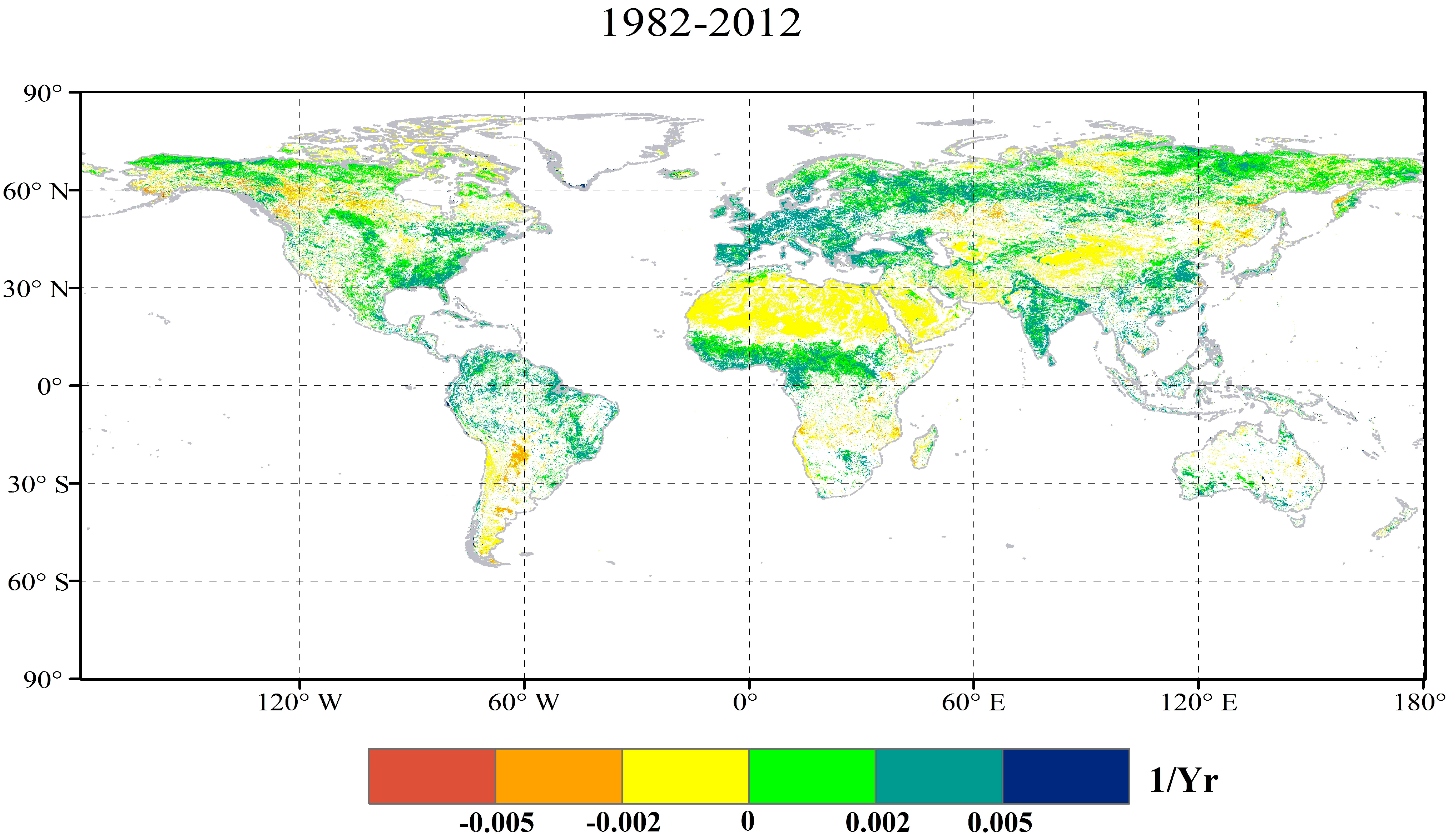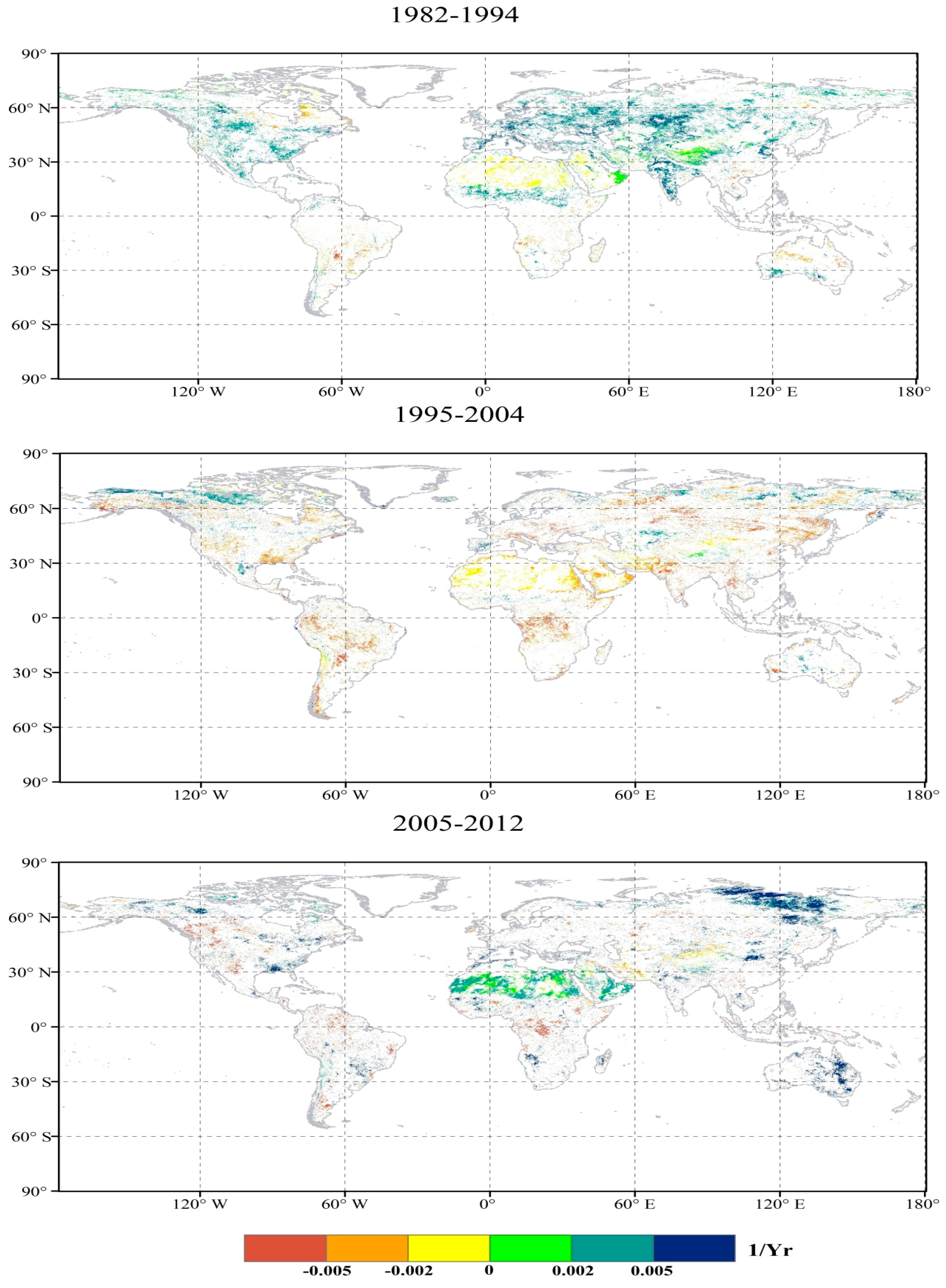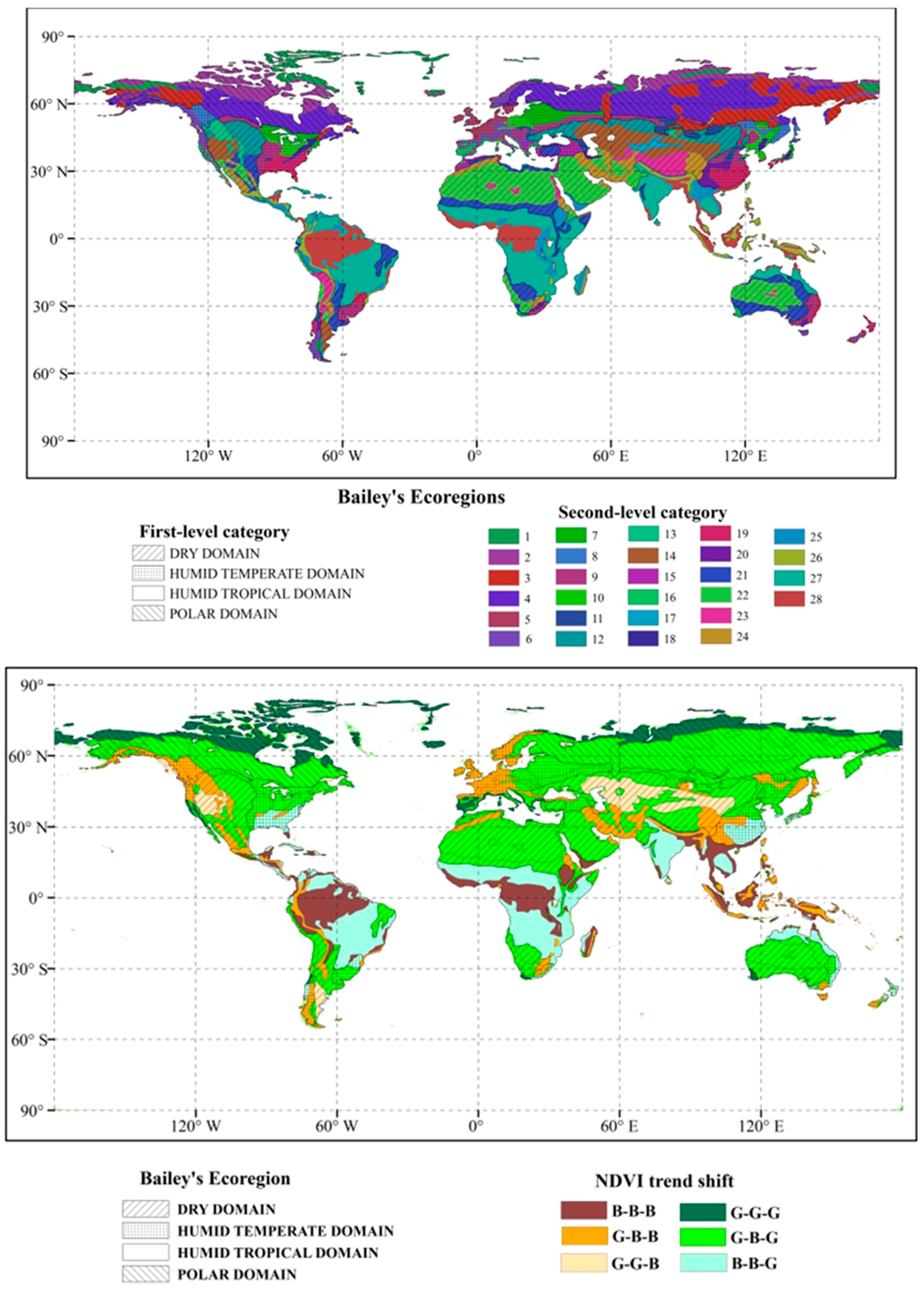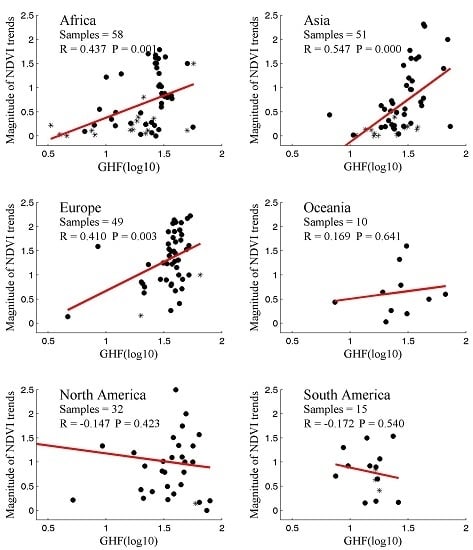Spatial and Temporal Patterns of Global NDVI Trends: Correlations with Climate and Human Factors
Abstract
:1. Introduction
2. Data and Methods
2.1. GIMMS NDVI3g Dataset
2.2. Climate Dataset
2.3. Global Human Footprint Dataset (from 1995 to 2004)
2.4. Bailey’s Ecoregions Map
2.5. Methods
3. Results and Discussions
3.1. Annual Change of NDVI


| 1st Level Category | 2nd Level Category | 1982–1994 | 1995–2004 | 2005–2012 | Trend Type | |
|---|---|---|---|---|---|---|
| 12 | Dry Domain | Temperate Steppe Division | 2.069 | −0.704 | 0.767 | G-B-G |
| 13 | Temperate Steppe Regime Mountains | 1.246 | −0.362 | −2.913 | G-B-B | |
| 14 | Temperate Desert Division | 1.107 | 0.256 | −0.444 | G-G-B | |
| 17 | Temperate Desert Regime Mountains | 1.867 | −0.271 | 1.093 | G-B-G | |
| 21 | Tropical/Subtropical Steppe Division | 0.563 | −0.720 | 3.389 | G-B-G | |
| 22 | Tropical/Subtropical Desert Division | 0.045 | −0.388 | 1.832 | G-B-G | |
| 23 | Tropical/Subtropical Desert Regime Mountains | 0.734 | −0.019 | 0.918 | G-B-G | |
| 24 | Tropical/Subtropical Steppe Regime Mountains | 0.890 | −0.868 | −0.143 | G-B-B | |
| 5 | Humid Temperate Domain | Marine Division | 2.324 | −0.496 | −1.958 | G-B-B |
| 6 | Marine Regime Mountains | 1.795 | −1.001 | −1.157 | G-B-B | |
| 7 | Warm Continental Division | 2.077 | −0.392 | 1.352 | G-B-G | |
| 8 | Warm Continental Regime Mountains | 0.671 | −1.361 | −1.507 | G-B-B | |
| 9 | Prairie Division | 1.394 | −1.547 | 1.792 | G-B-G | |
| 10 | Hot Continental Division | 1.805 | −1.807 | 0.282 | G-B-G | |
| 11 | Prairie Regime Mountains | 2.253 | −1.882 | 1.399 | G-B-G | |
| 15 | Mediterranean Regime Mountains | 1.790 | −1.182 | 4.006 | G-B-G | |
| 16 | Mediterranean Division | 1.875 | 0.478 | 2.565 | G-G-G | |
| 18 | Hot Continental Regime Mountains | 0.804 | −1.919 | 0.652 | G-B-G | |
| 19 | Subtropical Division | −0.028 | −1.363 | 1.831 | B-B-G | |
| 20 | Subtropical Regime Mountains | 0.155 | −1.239 | −0.551 | G-B-B | |
| 25 | Humid Tropical Domain | Savanna Regime Division | −0.439 | −2.042 | −0.514 | B-B-B |
| 26 | Rainforest Regime Mountains | 0.209 | −1.069 | −1.723 | G-B-B | |
| 27 | Savanna Division | −0.131 | −1.240 | 1.239 | B-B-G | |
| 28 | Rainforest Division | −0.377 | −1.149 | −2.159 | B-B-B | |
| 1 | Polar Domain | Tundra Regime Mountains | 0.486 | 1.562 | 1.532 | G-G-G |
| 2 | Tundra Division | 0.394 | 0.665 | 2.119 | G-G-G | |
| 3 | Subarctic Regime Mountains | 0.831 | −0.464 | 1.968 | G-B-G | |
| 4 | Subarctic Division | 1.082 | −0.843 | 1.117 | G-B-G | |
| Globally mean value | 0.649 | −0.552 | 0.974 | |||

3.2. Relationship between NDVI Trends and Temperature/Precipitation Trends
| Region | Dry Domain Region | Humid Temperate Domain Region | ||||||||
| Annual Change Rate (×10−3) | Partial Correlation | Annual Change Rate (×10−3) | Partial Correlation | |||||||
| NDVI | T °C/yr | P mm/yr | NDVI vs. T | NDVI vs. P | NDVI | T °C/yr | P mm/yr | NDVI vs. T | NDVI vs. P | |
| 1982–1994 | 0.652 | 0.730 | −0.057 | 0.414*** | 0.340*** | 1.621 | 1.159 | 1.891 | 0.318*** | 0.036(ns) |
| 1995–2004 | −0.413 | 1.408 | 0.168 | 0.147*** | 0.181*** | −0.717 | 1.964 | 2.461 | 0.100*** | 0.079*** |
| 2005–2012 | 1.007 | 1.510 | 0.493 | −0.415*** | 0.452*** | 2.347 | 2.329 | 6.390 | 0.071** | 0.230*** |
| Region | Humid Tropical Domain Region | Polar Domain Region | ||||||||
| Annual Change Rate (×10−3) | Partial Correlation | Annual Change Rate (×10−3) | Partial Correlation | |||||||
| NDVI | T °C/yr | P mm/yr | NDVI vs. T | NDVI vs. P | NDVI | T °C/yr | P mm/yr | NDVI vs. T | NDVI vs. P | |
| 1982–1994 | −0.197 | 0.035 | −1.612 | 0.208*** | 0.286*** | 0.841 | 1.955 | 0.979 | 0.149*** | 0.107*** |
| 1995–2004 | −1.189 | 0.131 | −0.087 | 0.147*** | 0.149*** | −0.028 | 2.641 | 2.498 | −0.217*** | −0.040* |
| 2005–2012 | −0.337 | −0.116 | −2.742 | 0.134*** | 0.248*** | 1.550 | 4.046 | 2.697 | 0.240*** | −0.089*** |
3.3. Relationship between NDVI Trends and Human Footprint

4. Conclusions
- (1).
- NDVI change has considerable spatial variability with both greening and browning during 1982–2012. Most parts of the Northern Hemisphere have exhibited significant greening trend over this 31-year period, while greening is observed less frequently in the Southern Hemisphere. In addition, NDVI trends have multi-year variations, showing an overall greening, browning, and greening for the periods 1982–2004, 1995–2004, and 2005–2012, respectively. The G-B-G pattern (greening–browning–greening) is the most prevalent type of temporal variability observed over the study period.
- (2).
- For the full period 1982–2012, there are positive correlations of NDVI trends with both temperature and precipitation across most regions (except for the Polar Domain Region). Such correlation with temperature trends became weaker over time, especially in the Humid Temperate and Humid Tropical Domain Region. The correlation with precipitation trends is stronger in the latest period (2005–2012) in the Dry Domain Region.
- (3).
- Significant positive correlation between human footprint and the magnitude of the NDVI trend in Asia, Africa, and Europe suggests that human activity actually accelerated NDVI changes in these continents.
Supplementary Files
Supplementary File 1Acknowledgments
Author Contributions
Conflicts of Interest
References
- Foley, J.A.; Levis, S.; Costa, M.H.; Cramer, W.; Pollard, D. Incorporating dynamic vegetation cover within global climate models. Ecol. Appl. 2000, 10, 1620–1632. [Google Scholar] [CrossRef]
- Linli, C.; Jun, S.; Yinming, Y.; Wenyi, F. Ten-day response of vegetation NDVI to the variation of temperature and precipitation in eastern China. Acta Geogr. Sin. 2009, 64, 850–860. [Google Scholar]
- Pettorelli, N.; Vik, J.O.; Mysterud, A.; Gaillard, J.M.; Tucker, C.J.; Stenseth, N.C. Using the satellite-derived NDVI to assess ecological responses to environmental change. Trends Ecol. Evol. 2005, 20, 503–510. [Google Scholar] [CrossRef] [PubMed]
- White, M.A.; de Beurs, K.M.; Didan, K.; Inouye, D.W.; Richardson, A.D.; Jensen, O.P.; O’Keefe, J.; Zhang, G.; Nemani, R.R.; van Leeuwen, W.J.D.; et al. Intercomparison, interpretation, and assessment of spring phenology in North America estimated from remote sensing for 1982–2006. Global Change Biol. 2009, 15, 2335–2359. [Google Scholar] [CrossRef]
- Tottrup, C.; Rasmussen, M.S. Mapping long-term changes in savannah crop productivity in Senegal through trend analysis of time series of remote sensing data. Agric. Ecosyst. Environ. 2004, 103, 545–560. [Google Scholar] [CrossRef]
- Metternicht, G.; Zinck, J.A.; Blanco, P.D.; Del Valle, H.F. Remote sensing of land degradation: Experiences from Latin America and the Caribbean. J. Environ. Qual. 2010, 39, 42–61. [Google Scholar] [CrossRef] [PubMed]
- Symeonakis, E.; Drake, N. Monitoring desertification and land degradation over Sub-Saharan Africa. Int. J. Remote Sens. 2004, 25, 573–592. [Google Scholar] [CrossRef]
- Tucker, C.J. Red and photographic infrared linear combinations for monitoring vegetation. Remote Sens. Environ. 1979, 8, 127–150. [Google Scholar] [CrossRef]
- Myneni, R.B.; Hall, F.G.; Sellers, P.J.; Marshak, A.L. The interpretation of spectral vegetation indexes. IEEE Trans. Geosci. Remote Sens. 1995, 33, 481–486. [Google Scholar] [CrossRef]
- Ollinger, S. Sources of variability in canopy reflectance and the convergent properties of plants. New Phytol. 2011, 189, 375–394. [Google Scholar] [CrossRef] [PubMed]
- Alcaraz-Segura, D.; Chuvieco, E.; Epstein, H.E.; Kasischke, E.S.; Trishchenko, A. Debating the greening vs. browning of the North American boreal forest: Differences between satellite datasets. Global Change Biol. 2009, 16, 760–770. [Google Scholar] [CrossRef]
- Tucker, C.J.; Slayback, D.A.; Pinzon, J.E.; Los, S.O.; Myneni, R.B.; Taylor, M.G. Higher northern latitude normalized difference vegetation index and growing season trends from 1982 to 1999. Int. J. Biometeorol. 2001, 45, 184–190. [Google Scholar] [CrossRef] [PubMed]
- Zhou, L.; Tucker, C.J.; Kaufmann, R.K.; Slayback, D.; Shabanov, N.V.; Myneni, R.B. Variations in northern vegetation activity inferred from satellite data of vegetation index during 1981 to 1999. J. Geophys. Res. 2001, 106, 20069–20083. [Google Scholar] [CrossRef]
- Bogaert, J.; Zhou, L.; Tucker, C.J.; Myneni, R.B.; Ceulemans, R. Evidence fora persistent and extensive greening trend in Eurasia inferred from satellite vegetation index data. J. Geophys. Res: Atmos. (1984–2012). 2002, 107, 1–14. [Google Scholar]
- Slayback, D.A.; Pinzon, J.E.; Los, S.O.; Tucker, C.J. Northern hemisphere photosynthetic trends 1982–1999. Global Change Biol. 2003, 9, 1–15. [Google Scholar] [CrossRef]
- Kawabata, A.; Ichii, K.; Yamaguchi, Y. Global monitoring of interannual changes in vegetation activities using NDVI and its relationships to temperature and precipitation. Int. J. Remote Sens. 2001, 22, 1377–1382. [Google Scholar] [CrossRef]
- Nemani, R.R.; Keeling, C.D.; Hashimoto, H.; Jolly, W.M.; Piper, S.C.; Tucker, C.J.; Myneni, R.B.; Running, S.W. Climate-driven increases in global terrestrial net primary production from 1982 to 1999. Science 2003, 300, 1560–1563. [Google Scholar] [CrossRef] [PubMed]
- Xiao, J.; Moody, A. Trends in vegetation activity and their climatic correlates: China 1982 to 1998. Int. J. Remote Sens. 2004, 25, 5669–5689. [Google Scholar] [CrossRef]
- Fensholt, R.; Rasmussen, K.; Nielsen, T.T.; Mbow, C. Evaluation of earth observation based long term vegetation trends—Intercomparing NDVI time series trend analysis consistency of Sahel from AVHRR GIMMS, Terra MODIS and SPOT VGT data. Remote Sens. Environ. 2009, 113, 1242–1255. [Google Scholar] [CrossRef]
- De Jong, R.; de Bruin, S.; de Wit, A.; Schaepman, M.E.; Dent, D.L. Analysis of monotonic greening and browning trends from global NDVI time-series. Remote Sens. Environ. 2011, 115, 692–702. [Google Scholar] [CrossRef] [Green Version]
- Goetz, S.J.; Bunn, A.G.; Fiske, G.J.; Houghton, R.A. Satellite-observed photosynthetic trends across boreal North America associated with climate and fire disturbance. Proc. Natl. Acad. Sci. USA 2005, 102, 13521–13525. [Google Scholar] [CrossRef] [PubMed]
- Lupo, F.; Reginster, I.; Lambin, E.F. Monitoring land-cover changes in West Africa with SPOT Vegetation: Impact of natural disasters in 1998–1999. Int. J. Remote Sens. 2001, 22, 2633–2639. [Google Scholar] [CrossRef]
- Evans, J.; Geerken, R. Discrimination between climate and human-induced dryland degradation. J. Arid Environ. 2004, 57, 535–554. [Google Scholar] [CrossRef]
- Wessels, K.J.; Prince, S.D.; Malherbe, J.; Small, J.; Frost, P.E.; Van Zyl, D. Can human-induced land degradation be distinguished from the effects of rainfall variability? A case study in South Africa. J. Arid Environ. 2007, 68, 271–297. [Google Scholar] [CrossRef]
- Lucht, W.; Prentice, C.; Myneni, R.B.; Sitch, S.; Friedlingstein, P.; Cramer, W.; Bousquet, P.; Buermann, W.; Smith, B. Climatic control of the high-latitude vegetation greening trend and Pinatubo effect. Science 2002, 296, 1687–1689. [Google Scholar] [CrossRef] [PubMed]
- Piao, S.L.; Fang, J.Y.; Zhou, L.; Zhu, B.; Tan, K.; Tao, S. Changes in vegetation net primary productivity from 1982 to 1999 in China. Global Biogeochem. Cy. 2005, 19, GB2027. [Google Scholar] [CrossRef]
- Mueller, T.; Dressler, G.; Tucker, C.J.; Pinzon, J.E.; Leimgruber, P.; Dubayah, R.O.; Hurtt, G.C.; Bohning-Gaese, K.; Fagan, W.F. Human land-use practices lead to global long-term increases in photosynthetic capacity. Remote Sens. 2014, 6, 5717–5731. [Google Scholar] [CrossRef]
- Baldi, G.; Nosetto, M.D.; Aragon, R.; Aversa, F.; Paruelo, J.M.; Jobbagy, E.G. Long-term satellite NDVI data sets: Evaluating their ability to detect ecosystem functional changes in South America. Sensors 2008, 8, 5397–5425. [Google Scholar] [CrossRef]
- Neigh, C.S.R.; Tucker, C.J.; Townshend, J.R.G. North American vegetation dynamics observed with multi-resolution satellite data. Remote Sens. Environ. 2008, 112, 1749–1772. [Google Scholar] [CrossRef]
- Pinzon, J.; Tucker, C. A non-stationary 1981–2012 AVHRR NDVI3g time series. Remote Sens. 2014, 6, 6929–6960. [Google Scholar] [CrossRef]
- Tucker, C.J.; Goff, T.; Townshend, J. African land-cover classification using satellite data. Science 1985, 227, 369–375. [Google Scholar] [CrossRef] [PubMed]
- Eastman, J.R.; Sangermano, F.; Machado, E.A.; Rogan, J.; Anyamba, A. Global trends in seasonality of normalized difference vegetation index (NDVI), 1982–2011. Remote Sens. 2013, 5, 4799–4818. [Google Scholar] [CrossRef]
- Holben, B.N. Characteristics of maximum-value composite images from temporal AVHRR data. Int. J. Remote Sens. 1986, 7, 1417–1434. [Google Scholar] [CrossRef]
- Mitchell, T.D.; Jones, P.D. An improved method of constructing a database of monthly climate observations and associated high-resolution grids. Int. J. Climatol. 2005, 25, 693–712. [Google Scholar] [CrossRef]
- Yang, X.C.; Zhang, Y.L.; Liu, L.S.; Zhang, W.; Ding, M.J.; Wang, Z.F. Sensitivity of surface air temperature change to land use/cover types in China. Sci. China Series D: Earth Sci. 2009, 52, 1207–1215. [Google Scholar] [CrossRef]
- University of East Anglia Climatic Research Unit; Jones, P.D.; Harris, I. CRU TS3.22: Climatic Research Unit (CRU) Time-Series (TS) Version 3.22 of High Resolution Gridded Data of Month-by-Month Variation in Climate (Jan. 1901–Dec. 2013); NCAS British Atmospheric Data Centre: Didcot, UK, 2014; Available online: http://www.cru.uea.ac.uk/data (accessed on 17 September 2014).
- Wildlife Conservation Society (WCS); Center for International Earth Science Information Network (CIESIN); Columbia University. Last of the Wild Project, Version 2, 2005 (LWP-2): Global Human Footprint Dataset (Geographic); NASA Socioeconomic Data and Applications Center (SEDAC): Palisades, NY, USA, 2005; Available online: http://sedac.ciesin.columbia.edu/wildareas/ (accessed on 11 November 2013).
- Bailey, R.G.; Hogg, H.C. A world ecoregions map for resource reporting. Environ. Conserv. 1986, 13, 195–202. [Google Scholar] [CrossRef]
- Bailey, R.G. Explanatory supplement to ecoregions map of the continents. Environ. Conserv. 1989, 16, 307–309. [Google Scholar] [CrossRef]
- Hoaglin, D.C.; Mosteller, F.; Tukey, J.W. Understanding Robust and Exploratory Data Analysis; Wiley: New York, NY, USA, 2000; Volume 3. [Google Scholar]
- Fensholt, R.; Proud, S.R. Evaluation of earth observation based global long term vegetation trends—Comparing GIMMS and MODIS global NDVI time series. Remote Sens. Environ. 2012, 119, 131–147. [Google Scholar] [CrossRef]
- Eastman, J. R.; Sangermano, F.; Ghimire, B.; Honglei, Z.; Hao, C.; Neeti, N.; Yongming, C.; Machado, E.A.; Crema, S.C. Seasonal trend analysis of image time series. Int. J. Remote Sens. 2009, 115, 692–702. [Google Scholar]
- De Jong, R.; Verbesselt, J.; Zeileis, A.; Schaepman, M. Shifts in global vegetation activity trends. Remote Sens. 2013, 5, 1117–1133. [Google Scholar] [CrossRef] [Green Version]
- De Jong, R.; Verbesselt, J.; Schaepman, M.E.; de Bruin, S. Trend changes in global greening and browning contribution of short-term trends to long-term change. Global Change Biol. 2012, 18, 642–655. [Google Scholar] [CrossRef]
- Zhang, Y.L.; Gao, J.G.; Liu, L.S.; Wang, Z.F.; Ding, M.J.; Yang, X.C. NDVI-based vegetation changes and their responses to climate change from 1982 to 2011: A case study in the Koshi River Basin in the middle Himalayas. Global Planet. Change 2013, 108, 139–148. [Google Scholar] [CrossRef]
- Chen, B.Z.; Xu, G.; Coops, N.C.; Ciais, P.; Innes, J.L.; Wang, G.Y.; Myneni, R.B.; Wang, T.L.; Krzyzanowski, J.; Li, Q.L.; et al. Changes in vegetation photosynthetic activity trends across the Asia-Pacific region over the last three decades. Remote Sens. Environ. 2014, 144, 28–41. [Google Scholar] [CrossRef]
- Piao, S.L.; Wang, X.; Ciais, P.; Zhu, B.; Wang, T.; Liu, J. Changes in satellite-derived vegetation growth trend in temperate and boreal Eurasia from 1982 to 2006. Global Change Biol. 2011, 17, 3228–3239. [Google Scholar] [CrossRef]
- Xiao, J.; Moody, A. Geographical distribution of global greening trends and their climatic correlates: 1982–1998. Int. J. Remote Sens. 2005, 26, 2371–2390. [Google Scholar] [CrossRef]
- Angert, A.; Biraud, S.; Bonfils, C.; Henning, C.C.; Buermann, W.; Pinzon, J.; Tucker, C.J.; Fung, I. Drier summers cancel out the CO2 uptake enhancement induced by warmer springs. Proc. Natl. Acad. Sci. USA 2005, 102, 10823–10827. [Google Scholar] [CrossRef] [PubMed]
- Lotsch, A.; Friedl, M.A.; Anderson, B.T.; Tucker, C.J. Response of terrestrial ecosystems to recent Northern Hemispheric drought. Geophys. Res. Lett. 2005, 32, L06705. [Google Scholar] [CrossRef]
- Park, H.S.; Sohn, B.J. Recent trends in changes of vegetation over East Asia coupled with temperature and rainfall variations. J. Geophys. Res. 2010, 115, D14101. [Google Scholar] [CrossRef]
- Piao, S.L.; Friedlingstein, P.; Ciais, P.; Zhou, L.; Chen, A. Effect of climate and CO2 changes on the greening of the Northern Hemisphere over the past two decades. Geophys. Res. Lett. 2006, 33, L23402. [Google Scholar] [CrossRef]
- Piao, S.L.; Nan, H.J.; Huntingford, C.; Ciais, P.; Friedlingstein, P.; Sitch, S.; Peng, S.S.; Ahlström, A.; Canadell, J.G.; Cong, N.; et al. Evidence for a weakening relationship between interannual temperature variability and northern vegetation activity. Nature Commun. 2014, 5. [Google Scholar] [CrossRef] [PubMed] [Green Version]
- Bounoua, L.; Hall, F.G.; Sellers, P.J.; Kumar, A.; Collatz, G.J.; Tucker, C.J.; Imhoff, M.L. Quantifying the negative feedback of vegetation to greenhouse warming: A modeling approach. Geophys. Res. Lett. 2010, 37, L23701. [Google Scholar] [CrossRef]
- Polley, H.W.; Johnson, H.B.; Fay, P.A.; Sanabria, J. Initial response of evapotranspiration from tall grass prairie vegetation to CO2 at subambient to elevated concentrations. Funct. Ecol. 2008, 22, 163–171. [Google Scholar]
- Donohue, R.J.; McVicar, T.R.; Roderick, M.L. Climate-related trends in Australian vegetation cover as inferred from satellite observations, 1981–2006. Global Change Biol. 2009, 15, 1025–1039. [Google Scholar] [CrossRef]
- Jeyaseelan, T.; Roy, P.S.; Young, S.S. Persistent changes in NDVI between 1982 and 2003 over India using AVHRR GIMMS (Global Inventory Modeling and Mapping Studies) data. Int. J. Remote Sens. 2007, 28, 4927–4946. [Google Scholar] [CrossRef]
- Begue, A.; Vintrou, E.; Ruelland, D.; Claden, M.; Dessay, N. Can a 25-year trend in Soudano-Sahelian vegetation dynamics be interpreted in terms of land use change? A remote sensing approach. Global Environ. Change 2011, 21, 413–420. [Google Scholar] [CrossRef]
- Propastin, P.A.; Kappas, M.; Muratova, N.R. Inter-annual changes in vegetation activities and their relationship to temperature and precipitation in central Asia from 1982 to 2003. J. Environ. Inform. 2008, 12, 75–87. [Google Scholar] [CrossRef]
- Mao, J.F.; Shi, X.Y.; Thornton, P.E.; Hoffman, F.M.; Zhu, Z.; Myneni, R.B. Global latitudinal-asymmetric vegetation growth trends and their driving mechanisms: 1982–2009. Remote Sens. 2013, 5, 1484–1497. [Google Scholar] [CrossRef]
© 2015 by the authors; licensee MDPI, Basel, Switzerland. This article is an open access article distributed under the terms and conditions of the Creative Commons Attribution license (http://creativecommons.org/licenses/by/4.0/).
Share and Cite
Liu, Y.; Li, Y.; Li, S.; Motesharrei, S. Spatial and Temporal Patterns of Global NDVI Trends: Correlations with Climate and Human Factors. Remote Sens. 2015, 7, 13233-13250. https://doi.org/10.3390/rs71013233
Liu Y, Li Y, Li S, Motesharrei S. Spatial and Temporal Patterns of Global NDVI Trends: Correlations with Climate and Human Factors. Remote Sensing. 2015; 7(10):13233-13250. https://doi.org/10.3390/rs71013233
Chicago/Turabian StyleLiu, Ya, Yan Li, Shuangcheng Li, and Safa Motesharrei. 2015. "Spatial and Temporal Patterns of Global NDVI Trends: Correlations with Climate and Human Factors" Remote Sensing 7, no. 10: 13233-13250. https://doi.org/10.3390/rs71013233
APA StyleLiu, Y., Li, Y., Li, S., & Motesharrei, S. (2015). Spatial and Temporal Patterns of Global NDVI Trends: Correlations with Climate and Human Factors. Remote Sensing, 7(10), 13233-13250. https://doi.org/10.3390/rs71013233






